Adult Colouring Books – Evolution of an unexpected phenomenon
By Vicky Stylianides
Dominating bestseller lists, the colouring book phenomenon shows no sign of letting up. With such a high demand, many illustrators are creating their own colouring books. No matter what the subject is or who the illustrator may be, they all offer a distraction – an antidote for the effects of modern day living. Christine Hohlbaum, author of The Power of Slow: 101 ways to save time in our 24/7 world, believes”that our 24/7 world – where we are always available and constantly plugged in – has a lot to do with our current state of anxiety.” By comparing three adult colouring books, Millie Marotta’s Animal Kingdom, James Gulliver Hancock’s Gulliver’s New Travels: Colouring in a New World and Jack Dowling and Dr. Stan Rodski’s Anti-stress series, I hope to get a sense of what creators believe the appeal is.

Published by Batsford
Mille Marotta published Animal Kingdom, one of the most successful chart topping colouring books in 2014, with 5.5 million copies sold worldwide it has remained in the Amazon top 100 for over 456 days, and counting. With two more books to date –Tropical Wonderland and Wild Savannah, I talk with Millie, delving into her thoughts about this phenomenon and her working process.
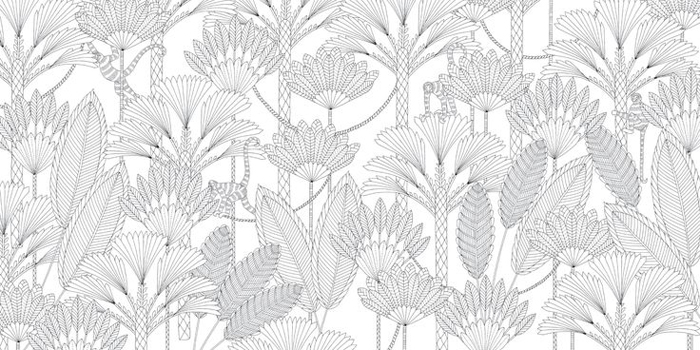
When did you realise colouring books were going to be a phenomenon, and what do you think is the appeal?
At the time of working on my first book Animal Kingdom colouring books really weren’t the phenomenon that they have become and I had no idea at that point that they would grow to be so popular. The idea of offering beautiful and sophisticated illustrations for people to colour just kind of made sense to me… as children most of us will have enjoyed colouring as a fun activity and a way to be creative, why should that stop simply because we have grown a little older? I don’t think that creativity or the desire to be creative, which is so strong in childhood, ever really leaves us. I think for many it just gets a little buried as we grow up and other things in our lives become more prominent.
These days we lead such busy fast-paced lives. We seem to be constantly multi-tasking and trying to cram as much as we can into one day and I think the main appeal of the books is simply that people find them a great way to relax and ‘switch off ‘ for a while. They offer a simple and enjoyable way to unwind in the form of a creative activity that is really accessible and very satisfying.
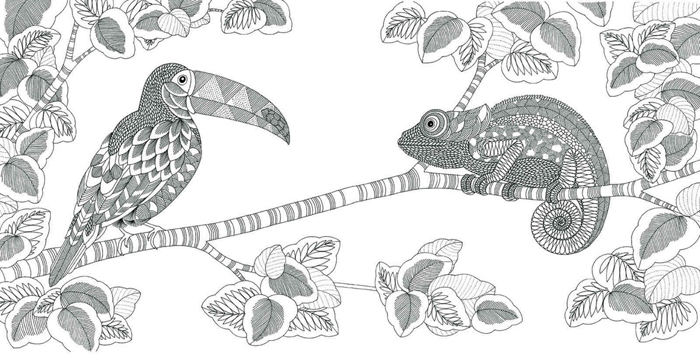
Do you think the colouring book craze has longevity, and do you see the concept evolving, perhaps including a narrative or tasks to be completed?
Yes I think it does. Aside from the enjoyment and satisfaction we as humans seem to get from creative pursuits, I think now people are understanding that these types of creative activities can be beneficial to our general well being we will continue to see people using colouring as a means of relaxation and a way to unwind. The books have become accepted as a genuinely relaxing and worthwhile activity, because of that I think they are here to stay.
Do you use the same approach to image making for a colouring book as you would do with freelance/commissions?
Yes pretty much, although I have had to adapt the way I work a little to make sure I’m creating images which people will find satisfying and enjoyable to colour. My style is much the same and I still use the same materials as I’ve used for a long time but the main difference is that my other illustration work will often be much more detailed. During the first and second book I did have to keep reminding myself that people need to be able to colour these images, it’s easy to get carried away with adding too much detail. Another big difference is that I’m not following or working to a client’s brief when I’m making a colouring book, so I have a lot more scope to just do my own thing, in that sense working on the books is very self indulgent.
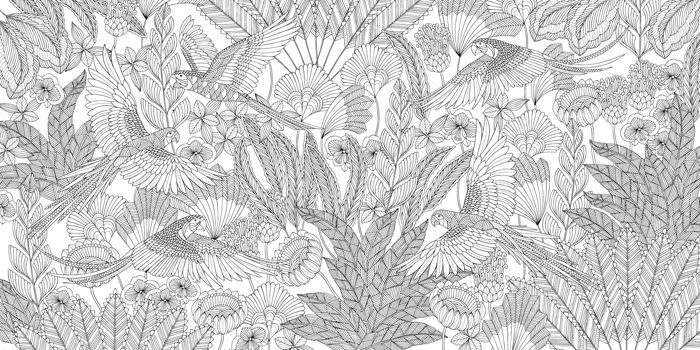
Does it feel strange to draw inspiration from such colourful places, to then see them in black and white as finished pieces, and how do you react to seeing them coloured in by the public?
No it doesn’t feel strange at all. Certainly the natural world is incredibly vibrant and full of colour, but that’s what makes it such a perfect subject for colouring books. In my drawings I love to explore pattern, texture and detail, working in just black and white allows me to strip everything else away and really focus on those things.
When I first published Animal Kingdom I did feel a little nervous about how people would respond to the illustrations, how they would work with them and what they would create or turn them into. But that all very quickly disappeared when I started to see the first examples of coloured pages from the books being shared over social media. This is happening on a level that I did not anticipate at the time of putting the first book together, I never really expected to be able to see so much of what people are doing in their books and have seen some of the most incredibly beautiful coloured images as a result. It’s fascinating to see how differently people approach each image, 500 people can all start off with the very same illustration but with their own particular colouring style, technique and choice of colours, each one of them will turn it into something completely unique and I love to see that.
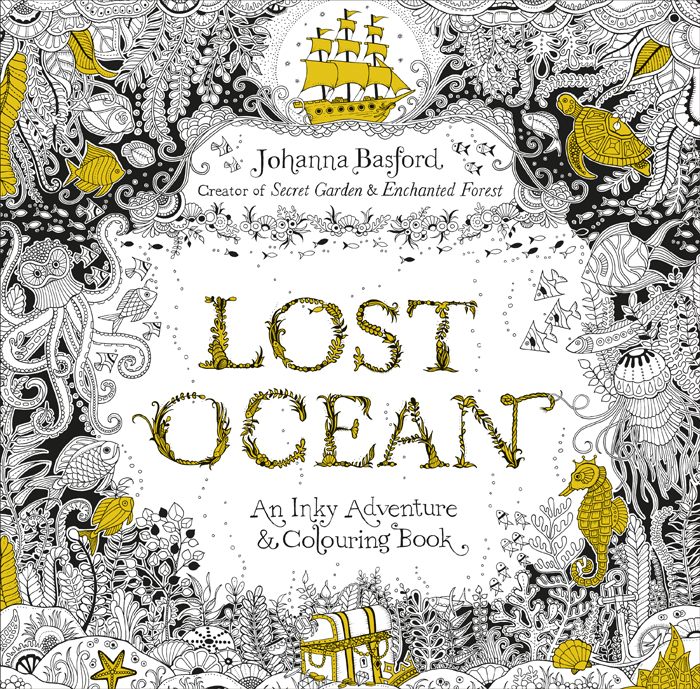
Johanna Basford is another success story. Her first book, Secret Garden, published in 2013, paved the way for adult colouring books. The idea was a natural progression from creating work as a commercial illustrator. Basford, who predominately works in black and white, received comments from clients and the public about wanting to colour in her work. An editor approached her, proposing a children’s colouring book, the reply was how about one for adults? Basford sees colouring books as one big collaboration, “I draw the outlines then the owner of the book brings the colour.” It’s about creating work without the hassle or worry of composition, layout and colour palette.
Illustrator James Gulliver Hancock is well known for his illustrations of buildings captured through his travels. His first colouring book Gulliver’s New Travels: Colouring in a New World, offers the opportunity to explore the world through colouring in. James talks about of his first colouring book and the anticipation of seeing his working coloured in by the public.
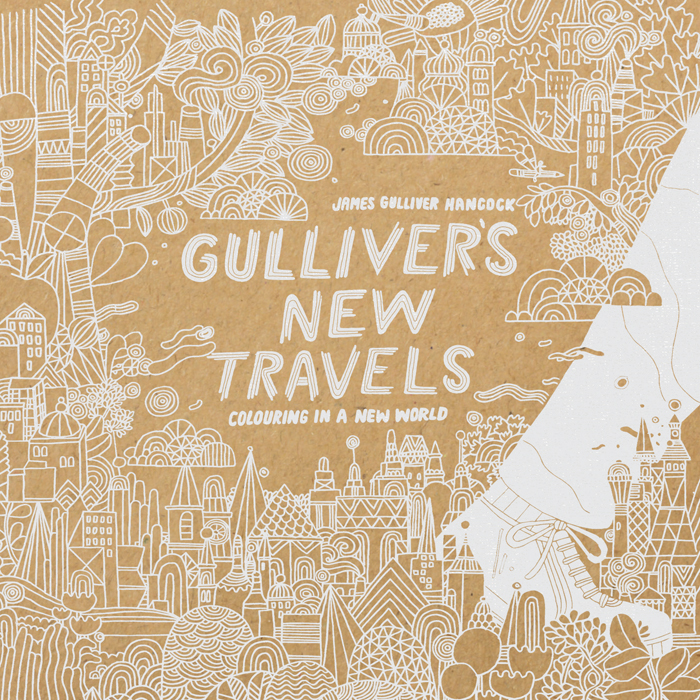
James Gulliver Hancock, Published by Batsford, April 2016
Gulliver’s New Travels: Colouring in a New World is a new take on the colouring book phenomenon. What was the idea behind creating a colouring book with the concept of a journey and exploration? Was the idea self generated or were you approached by a publisher?
I have always travelled, my largest journey being overland from Sydney, Australia to London, UK, so drawing as I travel and collecting experiences this way has always been a part of my work. My book All the Buildings in New York came out of travel, as have many other prints and projects. When Pavilion got in touch, the colouring book phenomena was in full swing, so I was excited to do one of my own. I worked with Tina at Pavilion on the concept, taking my love of travel and my middle name to work up the idea. I read Gulliver’s Travels again and ran with concepts in that, and ones I had been playing with while I travelled. A lot of the ideas came from experiences travelling through LA, NY, London, Hong Kong and Thailand with my musician wife (www.lenkamusic.com) . For example, the page with the luggage cart stacked high and the man on top is a moment with my son at LAX airport, where he was using our luggage cart as a walker frame, pushing our huge cart with his tiny legs.
Do you use the same approach to image making for a colouring book as you would do with freelance/commissions?
I mostly work in black and white, drawing the things around me like a visual diary, so the progression into a colouring book seemed natural to me. Colouring is not an integrated part of my process, rather a last step after the final drawings have been scanned, so to stop and focus entirely on the linework was a joy. I love colour and definitely have a favourite palette, but I’m excited to see how people interpret my line work.
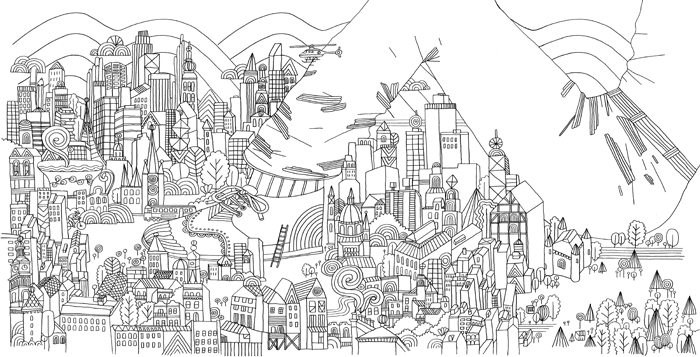
Does it feel strange to draw inspiration from such colourful places, to then see them in black and white as finished pieces?
No, like I said above, I love just drawing, I draw the things around me all the time I think I see the world in linework, sometimes when I’m waiting for something I’ll draw the things around me in my head, passing the line over the things around me. I take note of colour, but usually with photography as a reference for later. The way I enjoy and embrace the moment is through linework alone.
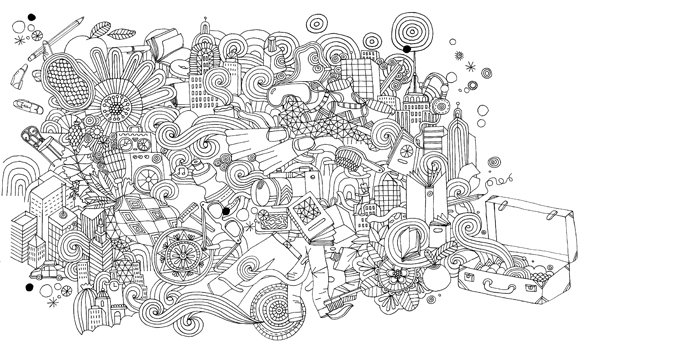
In a sense, you are giving up control of your illustrations and the end result, how do you think you will respond to seeing your illustrations coloured in by the public?
I can’t wait! Sometimes when I’m really busy with commissions, I get help with the colouring stage, so I’m used to having people colour in my work. I do however usually set the palette and do an example spread so this free reign will be thrilling. I’m sure I’ll find some of the colour combinations not within my palette and feel strange, but that’s part of the journey!
Another aspect of the colouring book market promotes mindfulness. Psychologists enthuse about their relaxation qualities – the simple task of filling in between the lines is enough to eliminate stress and improve mental wellbeing. In a sense, it’s art therapy, in the comfort of your own home. And it seems we can’t get enough of it.
Although many books promote mindfulness, they cannot guarantee it. It’s a spiritual state of being, but is there a science behind it? Dr. Stan Rodski and illustrator Jack Dowling, the creators of The Colouration Method, and The Anti-stress Colouring Book for Adults series, believe there is. Whilst many books work around themes of nature, animals and landscapes, The Colouration Methodinvolves colouring specific designs arranged around the principle of pattern and repetition. The illustrations prompt the mind to focus, which is the key to achieving mindfulness. Results suggest there is strong evidence to back up the improvement of mental wellbeing. Dr. Stan Rodski talks in greater depth about his studies and findings.
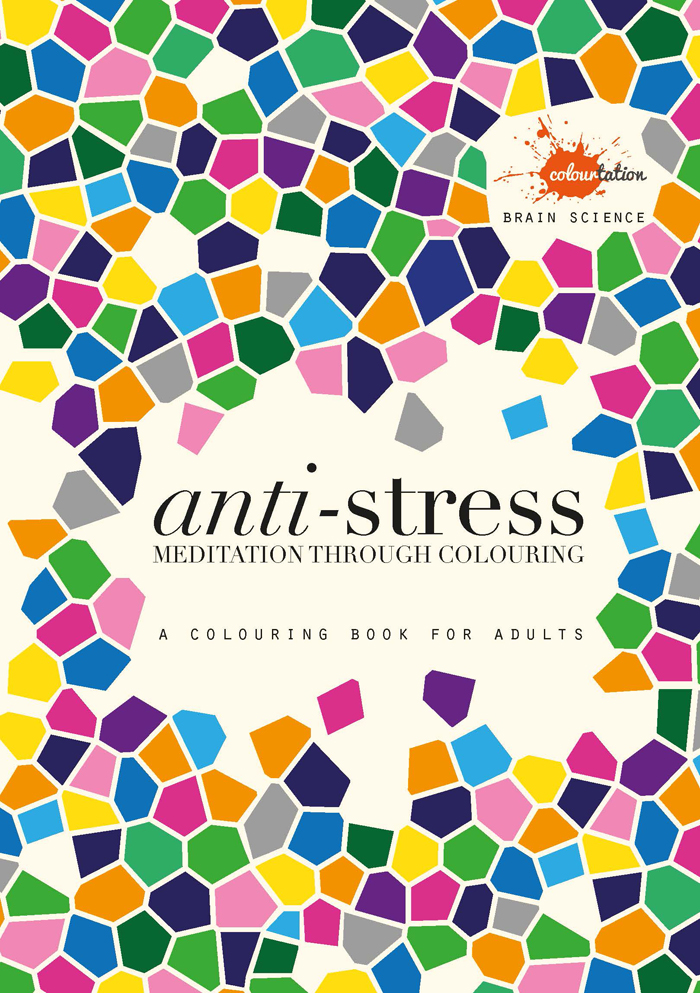
With many colouring books on the market promoting mindfulness, how does the concept of mindfullness compare with your scientific research?
For over three years we have used brain feedback tools such as EEG and ECG to monitor heart rate and brain wave activity of humans who are under stress.
The scientific literature is now quite clear of the benefits of meditation in creating both changes to heart rate and in particular heart rate variation and brain wave modulation to alpha wave as a result of meditation.
As researchers and counsellors our challenge was getting people to firstly take up meditation and secondly and importantly continue to use it.
It was only when we working with children and observing the changes in behaviour when colouring that the idea of using this to help adults ‘calm’ themselves was born. A room full of noisy adolescent school girls (Yr 10) at mid morning is something to behold. The quiet that is immediately created when they then start to colour in is equally mind changing. You can literally hear a pin drop.
This observation lead to 24 months of monitoring stressed adults using mainly EEG to observe the effects of colouring. The results of a five-minute focused colouring activity was to return the autonomic nervous system almost immediately to balance or homeostasis. This research can be found on our website www.colourtation.com .
How much has the research influenced the design of the book, and what was the relationship like between scientist and illustrator?
As the research progressed, it became clear that there were two levels of impact. The first level is one of enjoyment. We are happy to engage in an activity which generally has happy memories for most adults. A time when we were free to be creative. A time which was carefree with no responsibilities. For many people this is all they seek from colouring in books – some fun.
However, there is another level operating, which has a deep neuroscience layer to it. The brain in fact enjoys three, what are sometimes called, cognitive nutrients. It seeks order to its life, pattern and repetition. Just for a second see how you feel when, on any given day, things happen that don’t fit into some kind of order, you have never seen them before (no repetition) and there is simply no pattern to it – you will feel quite uncomfortable.
In our research and the books illustrations reflect the brains need for order (between the lines), repetition and pattern. Creativity comes from colour choices and positioning and not from some innate ability that many of us don’t even pretend to have. Jack, my illustrator and me, the neuroscientist, brought these specifications into our books.
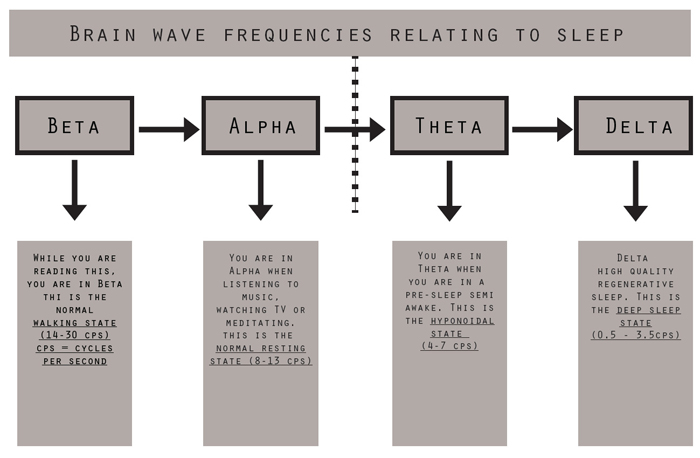
Are the acts of colouring in and the aesthetics of the final outcome equally important, and why do you think The Colouration Method is so successful?
The process of colouring is the important point here. In mindfulness it is about focus. Colouring in our patterns enable the brain to move quickly into a relaxed alpha wave. The colouration method, or focused colouring, can in as little as five minutes bring a congested brain into a relaxed state. The effect physiologically is to reduce cortisol and increase dopamine – create a relaxation effect.
If you just want to have fun and colour certain pictures like gardens, portraits, landscapes or tattoo’s then go ahead. But if you seriously want to relax and achieve a meditative state in the brain using up only a small amount of your precious time then using the coloutation method is required.
Do you think the colouring book phenomenon has longevity, and do you see the concept evolving, perhaps including a narrative or tasks to be completed?
Its longevity will be in the science. The practice of a technique using a neurologically derived image(s) for the purpose of helping our ever increasingly congested brain relax, remove dangerous proteins that may be coagulating will become increasingly important. This is particularly so when we see the science of meditation continuing to show its efficacy but fewer people practicing it because of time. This method is quick and effective. No excuses not to do it.
In terms of the future and where we are heading we now have an audio/sound available to be used in conjunction with our images to create a full meditative effect. Try this and see for yourself. Download our alpha sounds from the soundcloud app (https://soundcloud.com/colourtation). Put your earphones in and start the alpha sounds. Turn away from your computer, and choose any image from one of our colouration books. Focus on the process of colouring. The sound is background but is having the very important effect of magnifying the ALPHA or relaxed brain wave. Continue until the music stops then back to what you were doing before. On EEG monitors, showing the before and after effect constantly verifies the brains rapid and continuing achievement of homeostasis or relaxation.
Looking at three contrasting examples of adult colouring books, there is an overall sense of positivity and widespread appeal. Many user reviews reiterate the positive effects on mental wellbeing and sense of achievement: “This is a fantastic stress reliever – you seem to enter a new world where you are very focused and peaceful”, says an Amazon review of Millie Marotta’s Animal Kingdom. Following the success of Marotta and Johanna Basford, there has been a wave of new approaches, new subjects and new audiences. Illustrators are connecting with their audiences on a more personal level, users are benefiting from the calming effects and a sense of achievement from committing time to creating something personal and unique to them.
All of the adult colouring books act as catalyst for creativity, addressing one of the most stressful aspects for creative people – the fear of the elusive white page. What to draw, where to begin?! The adult colouring book eliminates this perception of skill and creativity being the same thing, acting as a prompt for those who want a creative outlet, but don’t necessarily see themselves as able.
Although the focus wasn’t on mindfulness, it seems impossible to talk about one without the other – psychologist, doctors, illustrators and the public are all talking about links to positive wellbeing, so with these benefits in mind it appears that colouring books are here to stay.
Back to News Page
